Flood Effects on Water Quality and Benthic Fauna Diversity in the Upper Chao Phraya River and the Lower Ping and Nan Rivers, Thailand
Tinnapan Netpae
Tinnapan Netpae*
Faculty of Science and Technology,Nakhon Sawan Rajabhat University,Thailand.
- Corresponding Author:
- Tinnapan Netpae
Tel: +66 (0)5621 9100
Fax: +66 (0)5622 1237
E-mail: tinnapan_net@yahoo.com
Abstract
The final quarter of the year 2011, wide space flooding in Thailand was heavily affected to ecosystem in rivers. This research aims to compare water quality and benthic fauna diversity of the upper Chao Phraya River and the lower Ping and Nan Rivers in Nakhon Sawan Province between before and after the flood. The parameters including water temperature, turbidity, pH, conductivity, DO, BOD5, NO3 --N, NH3-N, PO4 3-, coliform bacteria and fecal coliform bacteria were measured. In the aftermath of flood situation, the results indicate that water quality of rivers after the flood is lower than before the flood but both of them not lower than the surface water quality standard. Comparison of the benthic fauna diversity in rivers shows the significantly change as a result from the flood. Data collect after the flood shows the decreasing of the diversity and the evenness of benthic fauna in sites affected by flooding.
Keywords
Chao Phraya River; Ping River; Nan River; benthic fauna.
1. Introduction
The Chao Phraya River is the principal provider of water and many other resources that sustain Thai people communities,playing a pivotal role in people’s lives. The Chao Phraya River is a long river of Thailand (about 370 km). It runs through the central of Thailand,and then empties into the Gulf of Thailand. The Chao Phraya River begins at the conflux of the Nan and Ping Rivers at Nakhon Sawan province. In 2011,there was a great flood in the central of Thailand,especially in Chao Phraya basin area. It is the worst flood in five decade of Thailand [1]. One of the most affected areas is Nakhon Sawan province. The disaster of flash flood caused serious losses in term of people lives and properties. Flood runoff also cause the deterioration of downstream water quality because of the sediments and waste from the ground [6]. Contamination of water,especially by organic loading,can cause characteristic changes in benthic community and water quality [2]. Therefore,this research will provide information on the water qualities and the diversity of benthic fauna in the upper Chao Phraya River,the lower Ping and Nan Rivers. The results of this research will also be compared with other research done before the to determine any characteristic changes of water quality and the diversity of benthic fauna.
2. Methods
Study Area
Nakhon Sawan Province is the place where Ping and Nan Rivers combine together to form Chao Phraya River. In 2011,more than 5,300 cubic meters of flood water per second flow into the Chao Phraya River,whereas the river capacity is just 3,500 cubic meters per second [3]. The annual maximum rainfall averages 292.2 mm in August and the annual minimum rainfall averages 0 mm during January. The annual average temperature is 27.47 oC (up to 38.2 oC in April and down to 14.5 oC in January) [4].
Sampling Collection
Water and benthic fauna samples were collected from Ping River (site 1 to 4),Nan River (site 5 to 8) and Chao Phraya River (site 9 to 12) on March and April between year 2011 to 2012 representing respectively the wet and dry seasons (Figure 1). Sediment samples were collected by the Smith- McIntyre grab,while offshore samples were collected by the core sampler. Benthic fauna samples were collected from field and taken to the laboratory by fixed with 95% ethanol.
Determination of water quality and benthic fauna biodiversity
The water quality parameters at each site were measured in the field and in the laboratory as follows; temperature,turbidity,pH,conductivity,DO,BOD5,NO3 --N,NH3-N,PO4 3-,coliform bacteria and fecal coliform bacteria. All analysis were carried out according to the procedures by American Public Health Association [5]. While sediment samples were collected for identification of benthic fauna. Benthic fauna identification key written by Sangpradub and Boonsoong [6] was used to identify the collected specimens to the family level.
Calculation of indices
Water Quality Index: General Water Quality Index (WQI) is a great management and general administrative tool in communicating water quality information. This study aims at using the application of WQI in evaluating the quality of the upper Chao Phraya River,lower Ping and Nan Rivers before and after the flood. The WQI was calculated base on DO,BOD5,NO3-N,coliform bacteria and fecal coliform bacteria as described by Pollution Control Department (PCD),Thailand. Species Diversity and Evenness Index: The species diversity and the evenness of benthic fauna in all rivers were calculated from the Shannon-Wiener’s Index,Simpson’s Index,and Pielou’s evenness index respectively [7].
Statistical analysis
Flooding affected on water quality was evaluated with the one way analysis of variance (one - way ANOVA) and the Post Hoc. test and the Duncan test (P<0.01). Pearson correlation coefficient was used to determine the interdependence of the WQI variables and diversity indices.
3. Results and Discussion
Water quality from the upper Chao Phraya,the lower Ping and Nan Rivers
A summary of the water quality for the sites sampled between 2011 to 2012 in the upper Chao Phraya River and the lower Ping and Nan Rivers are given in Table 1,while WQIs of all rivers are depicted in Figure 2 .

In comparison with the surface water quality standard of Thailand,water in Ping,Nan and Chao Phraya Rivers are medium clean,except BOD5 is shown without water quality standards of Thailand. DO levels in all study sites during the dry season is higher than that of the wet season and the water quality standards indicating water quality deterioration. Water qualities of the rivers showes observable differences between before and after the flood. The results indicate that overall,the flooding seems to have the most impact on declining quality of water in the rivers. For certain pollutants such as BOD5,coliform bacteria and fecal coliform bacteria,there are increases in the average levels of them after the flood.
The application of PCD index reveals that WQI in the dry season is generally higher than in the wet season. However,WQI in both seasons can be classified into the same classification and beneficial use of the water. The scores of PCD water quality index range from 30-60,which correspond to a classification of poor water quality,except the water quality of the lower Ping River before the flood which is fair. In case of poor water quality,it is suitable for people to consume after customary water treatment and disinfection processes and for industry [8]. These indices show tendencies to indicate water in this study when consider concurrently with some environmental factor. Among all the sampling area in all rivers,the water quality of the upper Chao Phraya River is the most polluted as the WQI is the lowest. The commercial activities and the domestic waste water from Mung,Nakhon Sawan district are the important factors that causes the decrease of WQI in the upper Chao Phraya River. WQI in the upper Chao Phraya River is lower than the previous research reported in 1997 by Maketon et al. [9].
The indices indicated that the water qualities after the flood are worse than before the flood. Additionally,waste contaminants often found in floodwater can easily contaminate wells. Water quality in the rivers is change because it is affected by many factors including domestic and industrial waste water,sewage discharges,fuel products from overturned fuel tanks,or pesticides from agriculture area [10]. It is strongly impacted by runoff from flooding events. Previous studies of water quality changes from flooding have shown the declines in BOD,coliform bacteria and fecal coliform bacteria [11-13].
Benthic fauna diversity from upper Chao Phraya,lower Ping and Nan Rivers
Three Phylum of benthic fauna (Mollusca,Arthropoda and Annelida) were recorded during the study period. The number of family in all rivers is 22 and 18 families in before and after the flood respectively. The results show that Atyidae and Viviparidae are found at almost every river in every season,but Corixidae is the most abundant group while Atyidae ranks second. Specimen and family numbers in wet seasons are decrease. Data collected after the flood shows the initial decreases in the specimen and family numbers of benthic fauna in flood affected sites (Table 2 and Figure 3 ). The diversity indices and evenness indices of benthic fauna in the upper Chao Phraya River and the lower Ping and Nan Rivers are presented in Table 3. Species diversity indices show the tendency to indicate water quality in this study.
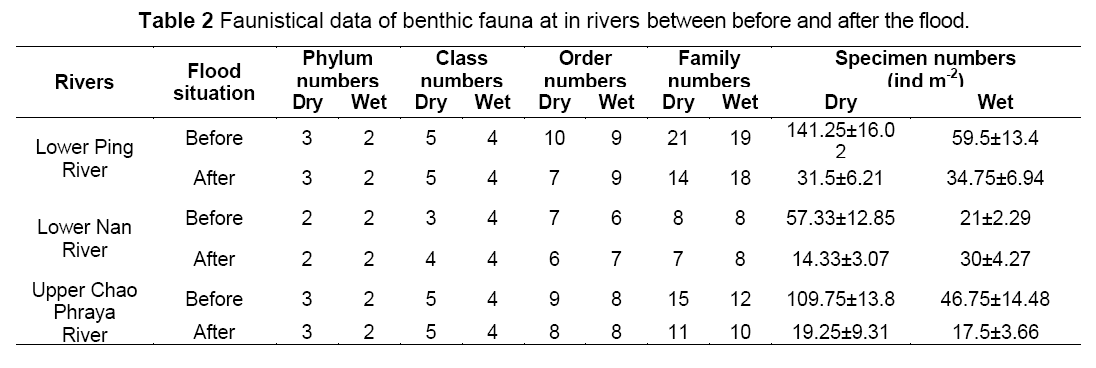
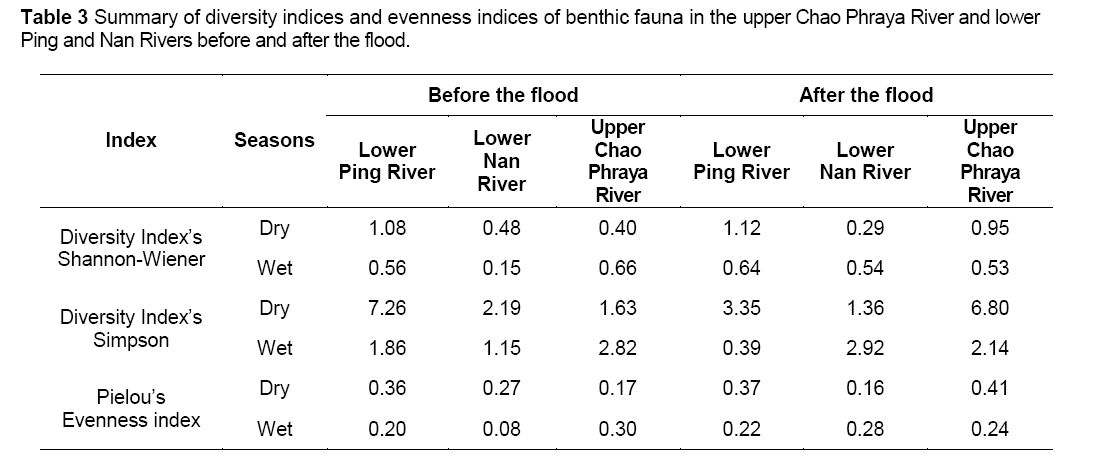
the water quality of all rivers still in good quality that suitable for normal growth of benthic faunas. The high diversity and evenness are observed during the dry season. The high diversity and evenness indices of benthic fauna are found in higher amounts in Ping River and the lower in Nan River. The community structures of benthic fauna in all rivers are influenced by the flood. Benthic fauna responds directly to the flood,which is similar to the findings of Robinson and Uehlinger [14] in Spol River,Switzerland. The flood obviously alters species composition in the high gradient portion of stream,increasing numbers of some,reducing numbers of other,and probably eliminating several species [2]. Velocities along the lateral margins of the stream also allow drifting benthic fauna to use behavioral adaptations such as swimming or body positioning to settle to the stream bottom more rapidly than they would by passive deposition [15,16].
4. Conclusion
The heavy flood in 2011 was the significantly effected of water quality degradation. In comparison with the surface water quality standards of Thailand,water quality both before and after the flood in upper Chao Phraya River,lower Ping and Nan Rivers was medium clean. The results clearly indicated that BOD5,coliform bacteria and fecal coliform bacteria were the major water parameters causing the degradation of water quality in the dry season. Moreover,the diversity and evenness of benthic fauna in all rivers were influenced by flood.
Acknowledgements
Financial support from Faculty of Science and Technology,Rajabhat Nakhon Sawan University are gratefully acknowledged. I sincerely appreciate all staff of Science Center,Nakhon Sawan Rajabhat University for providing facilities during the research work.
References
- Aon Benfield (2012) 2011 Thailand Floods Event Recap Report Impact Forecasting March 2012. Aon Corporation. Chicago.
- Hilsenhoff W.L. (1996) Effects of a Catastrophic Flood on the Insect Fauna of Otter Creek,Sauk County,Wisconsin. Transaction 8: 103-110.
- Sarnsamak P.,Saengpassa C (2012) Expert urges Channel to Drain Water from Chao Phraya River. The Nation. September 19.
- Thai Meteorological Department (2010) Weather Summary. [Online]. Available : https://www.met-sawan.tmd.go .th/data/data.htm (inthai).
- Clesceri L.S.,Greenberg A.E.,Eaton A.D. (1998) Standard Methods for Examination of Water and Wastewater,20th ed. American Public Health Association. Washington DC.
- Sangpradub N.,Boonsoong B. (2006) Identification of Freshwater Invertebrates of the Mekong River and Its Tributaries. – Mekong River Commission,Vientiane.
- Ludwig J.A.,Reynolds J.F. (1988) Statistical Ecology: a Primer on Methods and Computing. Wiley,New York.
- Singkran N.,Yenpiem A.,Sasitorn P. (2010) Determining Water Conditions in the Northeastern Rivers of Thailand Using Time Series and Water Quality Index Models. J. Sustain. Energ & Environ. 1: 47-58.
- Maketon M.,Kittiworachet R.,Somsiri C.,Ngamprayad T. (2000) Benthic Fauna and Water Quality in the Chao Phraya River,Thailand. In: Proceeding of the International Conference: The Chao Phraya Delta: Historical Development,Dynamics and Challenges of Thailand's Rice Bowl,2000,Thailand,1-12.
- Hickey J.T.,Salas J.D. (1995) Environmental Effects of Extreme Floods. Hydrometeorology,Impacts,and Management of Extreme Floods,1-23.
- Chu Y.,Salles C.,Tournoud M.G.,Got P.,Troussellier M.,Rodier C.,Caro A. (2011) Faecal Bacterial Loads During Flood Events in Northwestern Mediterranean Coastal Rivers. J. Hydrol. 405: 501-511.
- Chung S.W.,Ko I.H.,Kim Y.K. (2008) Effect of Reservoir Flushing on Downstream River Water Quality. J. Environ. Manag. 86: 139-147.
- Hrdinka T.,Novicky O.,Hanslik E.,Rieder M. (2012) Possible Impacts of Floods and Droughts on Water Quality. J. Hydro-Environ. Research. 6: 145-150.
- Robinson C.T.,Uehlinger U. (2008) Experimental Floods Cause Ecosystem Regime Shift in a Regulated River. Ecol. Appli. 18(2): 511-526.
- Ciborowski J.J.H.,Clifford H.F. (1983) Life Histories,Microdistribution and Drift of Two Mayfly (Ephemeroptera) Species in the Pembina River,Alberta,Canada. Holarct. Ecol. 6: 3-10.
- Imbert J.B.,Perry J.A. (2000) Drift and Benthic Invertebrate Responses to Stepwise and Abrupt Increases in Non-Scouring Flow. Hydrobiologia 436: 191-208.

Open Access Journals
- Aquaculture & Veterinary Science
- Chemistry & Chemical Sciences
- Clinical Sciences
- Engineering
- General Science
- Genetics & Molecular Biology
- Health Care & Nursing
- Immunology & Microbiology
- Materials Science
- Mathematics & Physics
- Medical Sciences
- Neurology & Psychiatry
- Oncology & Cancer Science
- Pharmaceutical Sciences
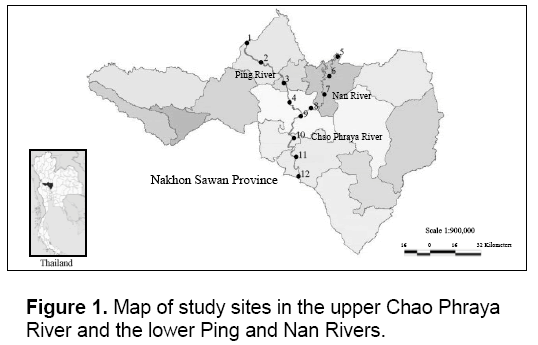
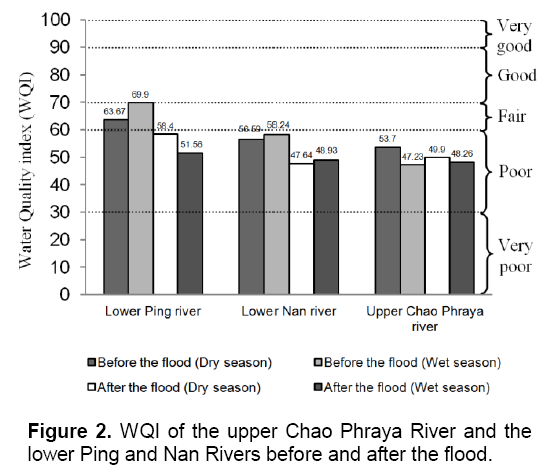
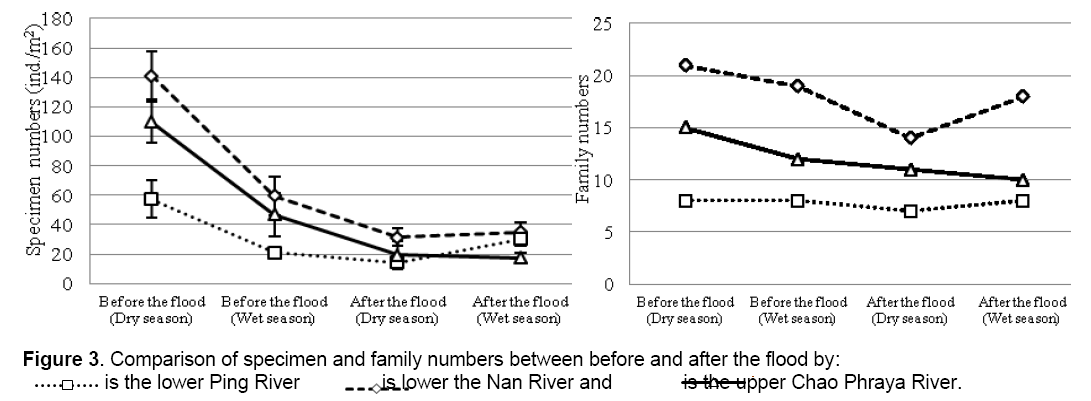
 is the lower Ping River
is the lower Ping River  is lower the Nan River and
is lower the Nan River and  is the upper Chao Phraya River.
is the upper Chao Phraya River.